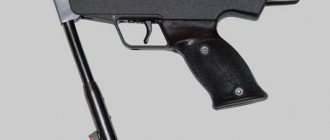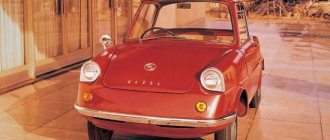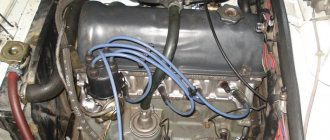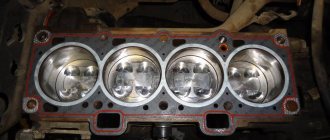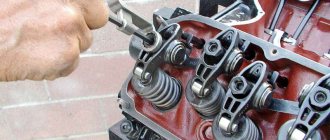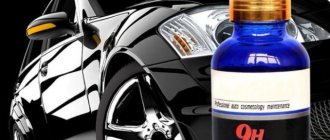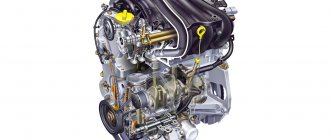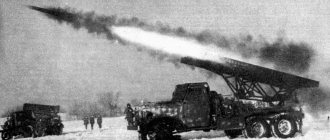Piston development history
Over the more than 140-year history of the development of internal combustion engines, the basic functions and design principles of pistons have not changed. This cylindrical part forms the lower half of the combustion chamber and transfers the energy of the gases expanding in the cylinder through the piston pin and connecting rod to the crankshaft. To prevent the breakthrough of gases into the crankcase and oil into the combustion chamber, as on the pistons of the very first engines, rings are installed. The working conditions became different - both loads and temperatures increased.
At the same time, engines run cleaner and their mileage is much higher than before. This is primarily associated with the main design changes, the use of new alloys of pistons and rings, and the widespread use of special coatings. The pistons become shorter and lighter. Part of the weight reduction was achieved by reducing both the overall height of the pistons and shortening individual elements.
Information - piston rings
The choice of rings is also influenced by the design of the engine lubrication system.
A system with a “wet” sump requires less elasticity from the oil retaining rings, while a system with a “dry” sump requires more elasticity. Over the past 30 years, the typical height of skirts has decreased from 60-65 mm to 35-40 mm. Such relief required reducing the gap between the piston and the cylinder walls to 0.025-0.125 mm in order to reduce its rocking during movement.
In sports engines, where there is practically no skirt at all, zero clearance or even a small interference is possible if the pistons have special anti-friction coatings. The distance from the center of the piston pin to the top of the piston crown, called compression height, has decreased from 38-44 mm to 30-33 mm over the same last three decades.
The shape of the piston crown surface also changed. Flats have given way to concave, more complex configurations that circulate the air-fuel mixture and improve exhaust gas removal. The most critical place on the piston is in the area of the upper compression ring. Just a decade ago, the height of the flame zone (the distance between the upper compression ring and the edge of the bottom) was usually 7.5 - 8.0 mm. Today it has decreased to 3.0-3.5 mm in most engines.
Piston information
Some piston crown designs are designed to reduce exhaust emissions and improve fuel economy.
In order for these indicators to remain within factory limits after the rebuild, pistons replaced on stock engines must have an identical crown shape. The movement of the compression ring closer to the top of the piston is largely caused by the struggle for complete combustion of the mixture and, as a result, to reduce harmful emissions. The fact is that the slot space between the flame belt and the cylinder wall creates a dead zone for the spread of the air-fuel mixture flame, and unburned fuel remains there. By itself, this amount is small, but if you multiply it by a quarter of the crankshaft speed and the number of cylinders, it becomes clear that the hydrocarbons hidden in this place significantly increase the level of CH in the engine exhaust.
Information - Racing Pistons
Additional machining of the bottom topography to accommodate large valves should be kept to a minimum.
Racing pistons come in all shapes and sizes, and products for most engines, including modified ones, are not that difficult to find in company catalogs. Due to the reduction in the heat zone, the compression ring has moved to a zone of high operating temperatures, which make the metal softer, which increases the risk of deformation of the annular groove, welding of the ring to the seat, or breakage of both the ring and the ring jumpers.
This required the use of more resistant materials, anodizing the ring groove. Thus, the design search for piston improvements is focused on geometric nuances, materials, weight, which depends directly on the first two characteristics, and the use of special coatings. The same aspects, but in finished form, are taken into account when choosing pistons when modifying the engine.
Choosing a piston when tuning - Geometry
First of all, the selection of a piston during tuning, as well as during a major overhaul of a power unit, is based on the geometric dependencies of its interior - the cylinder diameter, the piston stroke. crankshaft size, connecting rod length, recommended thermal clearances, cylinder head parameters (its height, combustion chamber design, valve dimensions and location). For low-budget projects, choosing a stock piston will be sufficient. In case of serious boosting of the power unit, it is worth paying attention to the tuning line of products or custom products, the design solutions of which are aimed at the specific requirements of the specific operation of the engine. Manufacturers offer aftermarket pistons with crown configurations that increase the combustion rate of the mixture, allowing the compression ratio to be increased without the risk of detonation. Often, special recesses are used not only to accommodate valve retainers, but also to eliminate critical hot spots in the combustion chamber, to increase the circulation of mixture flow and better exhaust gas removal.
How to choose piston rings
The selection of piston rings means that the dimensions of the piston rings must necessarily correspond to both the dimensions of the pistons and the dimensions of the cylinders. Let us add that selecting piston rings by size is a little easier compared to selecting the pistons themselves. This is due to the fact that repair piston compression and oil scraper rings for various engine models are more or less interchangeable today. This means that you can purchase both original piston rings and select parts from a third-party manufacturer.
Nuances of choosing pistons
Another unique design element found on pistons intended for tuning engines is the mini-finning of the area of the flame zone and on the bridge of the first and second rings. If the piston becomes too hot, then the top of the convexities of such fins contact the cylinder wall. This instantaneous contact helps cool the piston to reduce the risk of detonation and piston failure.
Some aftermarket pistons are made with pins that are offset slightly higher than stock to compensate for the grinding of the cylinder head and cylinder block mating surfaces. The use of such products is the best alternative to sawing off the top of the piston if the block mating planes have been processed, since the reduced depth of the recesses for the valves increases the risk of damage to the latter. Moving the pin location higher on the piston also allows the engine to use longer connecting rods, resulting in more torque and easier bearing and ring life.
Piston nuances
You can see small holes on the piston.
which are drilled in the annular grooves. They provide an increase in the force of pressing the ring against the groove. This makes it possible to use lighter rings to reduce friction forces during the piston stroke. Building several engines will give experience in determining the required skirt height, focusing on maximum power and operating speed ceiling, and based on the operating temperature range, cylinder head gasket thickness and compression ratio - the strength of the pistons. The closer to the top of the piston the rings are, the more pressure is created in the cylinder and the higher the torque and power of the engine. But at the same time, the work of the rings moves to a zone with a higher temperature, which forces them to make larger annular spaces and the rings themselves are thicker. Choosing a similar pattern for making a piston may also cause problems with the ability to organize the correct bottom topography.
The height above the ring may not be enough for the valve recesses. The reliability of conventional cast iron compression rings with a heat zone of 7.5-8 mm would be sufficient with a margin, but when it is reduced to 2.5-3 mm, such rings do not cope with their task. Therefore, modern motors use rings made of special grades of flexible cast iron or steel. The trend towards reducing the thickness of the compression ring began in the 80s. The typical thickness of today's compression rings is 1.2mm: 1.5mm for the second ring and 3.0mm for the oil control ring.
There are also thinner ones - compression ones with a thickness of 1.0 mm and 2 mm oil scraper ones. Approximately 40% of the friction losses in the engine are due to the operation of the rings; increasing their elasticity reduces the friction resistance in the cylinder during the piston stroke. Therefore, narrower and thinner rings began to be used by manufacturers in standard motors. This significantly affected fuel economy, temperature conditions and mileage of power units, since in addition to reducing friction losses, the shock loads transmitted to the piston and cylinder walls also decreased. But, on the other hand, thin rings transfer heat from the piston to the cylinder wall worse due to the smaller contact area with both. Consequently, pistons with such rings will be hotter than pistons with larger rings. Ring manufacturers give recommendations on this issue based on numerous tests, when after a certain mileage the motor is disassembled and its condition is checked.
Piston materials and weights
The alloy from which the piston is made not only determines its strength and wear resistance characteristics, but also its thermal expansion characteristics. Pistons offered on the aftermarket for tuning typically use alloys with a high silicon content. Most pistons were previously made from hypoeutectic aluminum alloys.
THE HIGHER THE ENGINE POWER, THE HIGHER THE NEED FOR COATINGS ON THE PISTONS
which contained from 8.5 to 10.5% silicon. Today we see more eutectic alloys, which have a silicon content of 11% and hypereutectic alloys, which have a silicon content of 12.5 to more than 16%. Silicon improves the material's strength resistance at high temperatures and reduces its expansion coefficient, so the thermal gaps between the piston and the cylinder walls can be smaller. Hypereutectic pistons have a coefficient of thermal expansion that is approximately 15% less than that of standard pistons. Therefore, when choosing such a piston, you need to adjust the gap specified by the manufacturer. Hypereutectic alloys are also somewhat lighter (about 2%) than the materials used in standard motors. But castings are often made thinner because the alloy is stronger, which ultimately leads to a reduction in the total mass of the piston by up to 10%.
Hypereugectic alloys are more difficult to cast. because it is difficult to keep silicon evenly dispersed throughout the volume of aluminum while the metal is cooling. Particle size must also be carefully controlled to ensure that the piston does not become brittle or have large solids that interfere with machining. Some pistons undergo a special heat treatment that improves the grain structure for increased strength and wear resistance.
Information - piston wear
Friction during cold and dry starts contributes to increased wear of engine parts.
Engines with self-contained lubrication systems, equipped with sprayers that can turn on before the engine starts, could overcome this problem. But most modern engines have a smear system with oil pumps that start working only at the moment the crankshaft turns. So, piston coating is not a luxury, but a necessity. Heating only the oil before starting, which is quite often used by car enthusiasts in our country, does not guarantee the absence of wear, since it does not eliminate increased cold clearances when the block is cold. This problem can only be eliminated by autonomous heating of the cooling system. Such heaters raise the temperature of an idle engine to 80 °C. After such heat treatment, these figures can increase up to 30%. Mechanical processing of pistons made of hypereutectic alloys is more difficult due to their hardness, and therefore their cost, as a rule, is somewhat higher than standard ones. For a conveyor, such material is expensive. The choice of the weight of the pistons and the material from which they are made is largely (though not entirely) determined by the required strength of the parts for the loads in the power unit being built. Mileage is the main criterion, unless, of course, the car is planned to be rebuilt before each race.
The weight of the pistons used can be reduced in several ways. One of them is to embed oil injectors into the cylinder block. The oil they spray cools the pistons, saving weight by using a thinner bottom wall design. Another way is to use pistons with short skirts, designed for high-revving engines, which will also reduce weight; lighter pistons will make it easier to spin the engine, but you should be extremely careful in your choice.
Causes of piston group wear
Constant operation of the machine inevitably leads to damage to the steam generator. Like any other element of the power unit, pistons wear out due to obsolescence or due to overheating caused by a disruption in the combustion process.
What causes piston crown wear?
Seizures on the piston bottom are formed due to clogging or deformation of the oil nozzle, installation of elements with different sizes, or a malfunction in the cooling system.
Pistons on used cars often show impact marks. They are caused by an overly large piston protrusion or improper adjustment of the end side of the cylinder head. This also happens due to engine oil deposits on the head of the element, an unusually narrow gap in the valve drive and incorrect installation of the gas valve phases.
Piston coatings
The need for coatings depends on how extreme the operating conditions are. The higher the engine boost, the higher the need. Friction losses can amount to more than horsepower, cause excessive wear and increase the temperature of engine parts. Heating is especially noticeable on the piston skirt and in the piston pin hole. Anti-wear coatings extend piston life. Today, many production engines use pistons with a graphite-disulfide-molybdenum coating on the piston skirt, which reduces frictional resistance, and most aftermarket piston manufacturers also offer some type of coated pistons intended as a replacement for stock items during repair and tuning.
But coatings on products are designed to combat not only friction. During engine operation, it is desirable that the high temperature in the combustion chamber be transferred to the piston as little as possible. A hot, hot piston is the source for self-ignition of the mixture and detonation. In addition, high temperature changes the hardness of the material, which reduces the mileage of the pistons not only due to increased wear, but can also cause their destruction due to thermal warping. Ceramic-metal piston crown coatings are a type of coating that acts as a thermal barrier. Maintaining a high temperature in the combustion chamber increases thermal efficiency and produces more power. This also helps keep the piston from getting too hot. True, too high a temperature in the combustion chamber also increases the risk of detonation and self-ignition. When pistons with similar coatings are installed on engines, the ignition timing is usually reduced by several degrees.
Piston design
The approach to piston design has also changed, which at the dawn of engine building was an ordinary process of trial and error.
Numerous prototypes were tested for a long time, gradually approaching the desired indicators before the correct part was obtained. Today, the volume of full-scale testing has been reduced to a minimum of 3a Count 30 - modeling of parts on a computer. After the design has been developed using the finite element method, the virtual results are verified on a plastic prototype by photoelastic stress analysis. And only after this the “live” product as part of the engine will go to the test bench. The formation of carbon deposits on the lower surface of the piston bottom, which weigh it down, is completely undesirable. The process of formation of such excesses is especially active when installing oil cooling nozzles. Special piston coatings can reduce the time that oil spends on the base of the piston, and therefore the ability to create oil “cooking”. Anodizing the compression ring groove, as a way to combat welding of the ring to the piston material under high temperature, is used in many production models of modern engines. But this coating, about 20 microns thick, is not omnipotent; the anodized piston can fail, becoming overheated. Some manufacturers of non-serial products use nickel alloy inserts in the annular groove instead of anodizing. The need for design features is extremely difficult to calculate based only on numbers. Therefore, when choosing pistons, it is better to turn to those who can give advice based on operating experience. And already on the list. compiled by a master. decide on preferences.
Technology
The elastic deformation of the rings can be determined by the force of movement of the piston in the cylinder. The piston with installed rings and a pin assembled with a connecting rod is inserted into the cylinder bore upside down. The piston is then moved in the cylinder, and the connecting rod can be connected to a scale that will display the force overcome by the piston. The higher the resistance, the less elasticity of the rings; this technique is applicable only after the engine has gone through a normal run-in cycle, that is, before reassembly. Order a piston
Decarbonization of piston rings
If the engine starts to smoke, there is a possibility that there are rings stuck in the piston grooves. Nowadays, there are many different modern means for decarbonizing piston rings, and many drivers use them to restore engine performance. Among the most popular compositions are:
- Nitrox Power;
- LAVR ML-202;
- Titanium;
- LIQUI MOLY;
- WYNN'S.
Motorists believe that if the engine starts smoking, you need to use a decarbonizer, and the engine will work as before, without oil consumption and without smoke. Indeed, sometimes these remedies help, but only in cases where the motor has stood motionless for a long time (for example, after winter), and moisture has accumulated in it. If the car is subject to long-term preservation (put in a garage for winter storage), you should remove the spark plugs and pour oil into the cylinders, and plug the spark plug holes with plugs. With such prevention, the spark plugs will not become damp and rust will not accumulate on the sleeves.
But if, after all, a forgetful car owner has not taken preventive measures, you can use a decarbonizer. We get rid of rust in cylinders as follows:
- pull off high-voltage wires;
- unscrew all spark plugs;
- rotate the crankshaft so that all pistons are in the middle position;
- pour 45 ml of liquid into each cylinder, install spark plugs;
- leave the cylinders to “soak” for 6-7 hours;
- why do we turn out the spark plugs, turn the starter a few revolutions so that all the dirt flies out of the engine;
- We put the removed parts back in place and start the engine. At first it may smoke a lot, but then the smoke will go away.
Car owners should remember that decarbonization is not a panacea for all ills, and if the piston rings are worn out, then only replacing them will help.
When repairing car engines of various brands and models, situations sometimes arise when the required part cannot be quickly found. As a rule, this means that you need to place an order, and then the required part can only be received after 5 - 12 days from abroad. In some cases, such a period may be undesirable or even unacceptable. Is there a way to find alternative solutions?
